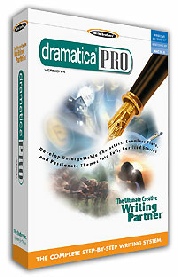Your Story's Mind
To an audience, every story has a distinct personality, almost as if it were a person rather than a work of fiction. As with the people we meet, some stories are memorable and others we forget as soon as they are gone. Some are the life of the party, but get stale rather quickly. Some initially strike us as dull, but become familiar to the point we look forward to seeing them again.
When we first encounter a person or a story, we tend to classify it in broad categories. We might label someone as a bully, a nerd, or a money-grubbing shark. Similarly, we might label a story as a Romance, an Adventure, or a situation comedy. As with the people we meet, the more time we spend with stories the less we see them as generalized types and the more we see the traits that define them as individuals.
Some stories might like to scare us, some to make us laugh. One story might be interested in the Civil War while another is heavily into science fiction. One story might be slow going and one charged with nervous energy.
The personality of a story is created by the combination the subject matter and the manner in which it is expressed. It is the personality of a story that defines its genre.
Like real people, stories suffer from conflicting drives, represented by the characters. They struggle with conflicting vlaue standards, as illustrated in the theme. And, they try various methods to resolve their troubles, documented in the plot.
In short, characters are the motivations of the Story Mind, theme its reasessment of values, plot its problem solving techniques, and genre its overall personality.
When an audience sits down with a book, in a theater, or in front of a television, it is sitting down with a person to make conversation. In fact, it is a one-sided conversation. Your story must have a personality intriguing enough to hold the audience's interest until the show is over.
Is your story a good enough conversationalist, or does it need to go back to finishing school with another draft before it is ready for prime time? You have days, months, perhaps even years to prepare your story to exude enough charisma to sustain just one conversation. How disappointing is it to an audience when a story's personality is plain and simply dull?
As an author, thinking of your story as a person can actually help you write the story. All too often, authors get mired in the details of a story, trying to cram everything in and make all the pieces fit.
Characters are seen only as individuals, so they often unintentionally overlap each other's dramatic functions. The genre is depersonalized so that the author trying to write within a genre ends up fashioning a formula story and breaking no new ground. The plot becomes an exercise in logistics, and the theme emerges as a black and white pontification that hits the audience like a brick.
Now imagine that you are sitting down to dinner with your story. For convenience, we'll call your story "Joe." You know that Joe is something of an authority on a subject in which your are interested. You offer him an appetizer, and between bites of pate, he tells you of his adventures and experiences.
Over soup, he describes what was driving him at various points of his endeavors. These are your characters, and they must all be aspects of Joe's personality. There can be no characters that would not naturally co-exist in a single individual. You listen carefully to make sure Joe is not a split-personality, for such a story would seem fragmented as if it were of two or more minds.
While munching on a spinach salad, Joe describes his efforts to resolve the problems that grew out of his journey. This is your plot, and all reasonable efforts need to be covered. You note what he is saying, just an an audience will, to be sure there are no flaws in his logic. There can also be no missing approaches that obviously should have been tried, or Joe will sound like an idiot.
Over the main course of poached quail eggs and Cohoe salmon (on a bed of grilled seasonal greens), Joe illucidates the moral dilemmas he faced, how he considered what was good and bad, better or worse. This is your theme, and all sides of the issues must be explored. If Joe is one-sided in this regard, he will come off as bigoted or closed-minded. Rather than being swayed by his conclusions, you (and an audience) will find him boorish and will disregard his passionate prognositications.
Dessert is served and you make time, between spoonfuls of chocolate soufle (put in the oven before the first course to ready by the end of dinner) to consider your dinner guest. Was he entertaining? Did he make sense? Did he touch on topical issues with light-handed thoughtfulness? Did he seem centers, together, and focused? And most important, would you invite him to dinner again? If you can't answer yes to each of these questions, you need to send your story back to finishing school, for he is not ready to entertain an audience.
Your story is your child. You give birth to it, you nurture it, you have hopes for it. You try to instill your values, to give it the tools it needs to succeed and to point it in the right direction. But, like all children, there comes a time where you have to let go of who you wanted it to be and to love and accept who it has become.
When your story entertains an audience, you will not be there to explain its faults or compensate for its shortcomings. You must be sure your child is prepared to stand alone, to do well for itself and to not embarassed you. If you are not sure, you must send it back to school.
Personifying a story allows an author to step back from the role of creator and to experience the story as an audience will. This is not to say that each and every detail in oot importat, but rather that the details are no more or less important than the overall impact of the story as a whole. This overview is one of the benefits of looking at a story as a Story Mind.
But what of the details? After all, the overview only gets one in touch with the big picture, yet every big picture is made through hundreds of brush strokes.
In the sections that follow, we'll begin to psychoanalyze the Story Mind to learn the specific details about its drives (characters), value standards (theme), problem solving techniques (plot), and overall personality (genre). As we identify the Elements of Story Structure, we will explore how to use them to construct complete blueprints for our own stories that are complete, sound, and provide form without formula.
Saturday, May 2, 2009
Subscribe to:
Post Comments (Atom)







No comments:
Post a Comment